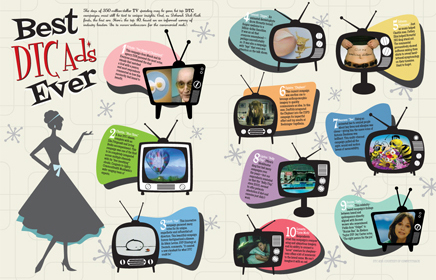The days of 350-million dollar TV spending may be gone, but top DTC campaigns must still be tied to unique insights. And, as Deborah Dick-Rath finds, the best are. Here’s the top 10, based on an informal survey of industry leaders

DTC has evolved over the last few years to be a key marketing tool for successful pharmaceutical brands. This evolution reflects the growth of patient empowerment, the acceleration of the information age and, because of managed care, the decrease in time patients and physicians have to discuss options.
Sixteen years ago, when the FDA finally “allowed” pharmaceutical companies to advertise their Rx products “directly to consumers”—on TV and in magazines—those companies had no idea how to do it. They had built mega, multi-billion-dollar brands simply by having reps call on doctors. They had never used the mass communications techniques or emotional branding associated with consumer goods.
Also, in those days, the internet and online marketing were in their infancy. (Mark Zuckerberg was still in high school.) Yet, healthcare organizations wholeheartedly embraced this new opportunity to promote their Rx drugs and quickly developed research and modeling disciplines to prove out these new marketing investments.
For this month’s DTC cover story, we conducted an informal survey of healthcare industry leaders in the marketing, media and advertising sectors to find out which DTC campaigns were most memorable—The Best—and why. The winners are not surprising. For the most part, they reflected large therapeutic categories and represent three large pharma companies—Merck, Pfizer and Novartis. Five of the top 10 ads used an anthropomorphic icon to deliver the story. Only one used a celebrity.
See if you agree with your colleagues’ picks:
1 Vytorin: “Two Kinds of Cholesterol.” This campaign from Merck and its agency DDB garnered the most votes. Everyone remembered the dual visuals that matched a food with a person, and most respondents commented on how this succinctly tied brand to benefit.
2 Claritin: “Blue Skies.” A true DTC classic, complete with an Ella Fitzgerald and Irving Berlin accompaniment. This campaign was one of the first to be completely integrated across multiple channels with its “free breathing” clouds. Congrats to Ogilvy CommonHealth Worldwide’s wide-ranging team of experts.
3 Zoloft: “Dot.” This innovative campaign garnered many votes for its unique, empathetic and influential art direction. This beautiful campaign forever destigmatized a disease. As Adam Levine, SVP Strategy at Deutsch, comments, “It created a new standard for what DTC could be.”
4 Lamisil: “Digger.” An animated dermatophyte drove Novartis toenail fungus medicine to a billion-dollar franchise. It was an ad that everyone remembered—perhaps uncomfortably so. It was also a campaign with “legs” that even won attention on the talk shows.
5 Zelnorm: “Tummies.” Just as music helped Claritin soar, Fatboy Slim helped Novartis’ IBS drug stand out. The commercial provocatively showed sufferers raising their shirts to reveal hand-lettered symptomology on their tummies. Hard to forget.
6 Spiriva: “Elephant.” This current campaign was another one to leverage anthropomorphic imagery to quickly communicate an idea. In this case, Draftfcb integrated the Elephant into the COPD campaign for impactful effect and top results at Boehringer-Ingelheim.
7 Nasonex: “Bee.” Using an animated bee to remind people about hay fever and allergies was clever—giving him the suave voice of Antonio Banderas was brilliant. This multi-channel campaign pulled all the sight, sound and motion levers of memorability.
8 Lipitor: “Belly Flop.” Pfizer’s blockbuster drug has had many campaigns over the years—but our respondents reminded us that the “Belly Flop,” circa 2003, seemed to offer patients absolution if diet and exercise just didn’t work.
9 Boniva: “Sally Field.” This celebrity-based campaign’s linkage between brand and spokesperson directly
aligned with Boomer women who remembered Field from “Gidget” to “Norma Rae.” As Abelson Taylor SVP Jay Carter notes, “The right person for the job.”
10 Lunesta: “Luna Moth.” Respondents cited this campaign’s overpowering and ubiquitous imagery, and its ability to connect a “lunar” creature for sleeplessness offers a bit of mnemonic to the brand name. We can’t imagine it with an owl.
Although there were many runner-ups—including Viagra (“A Man Fixes Things”), Cialis (“Tubs”), Nexium (“Purple Pill”) and Gardasil (“One Less”)—the 10 ads listed above were deemed “The Best” by our respondents.
Besides noticing that these winning campaigns were from mainly broad categories like lipidemia or from big DTC advertisers like Merck, or that anthropomorphic characters are popular, we repeatedly heard that these campaigns were “breaking new ground” or were well-connected to a patient insight.
Cathy Downey, a director at Ironwood Pharmaceuticals, noted, “These campaigns used single-minded insights translated into memorable and impactful creative that built brands and drove consumers to act for better care.” Monique Levy, VP at Manhattan Research, commented that DTC made conditions such as ED “feel normal and mainstream.”
Today’s fractionalized media environment demands more sophisticated DTC campaigning and more highly targeted activity. The days of $350-million TV spending may be behind us and the days of social networking, blogging and gaming lie ahead—and that’s exciting for DTC marketers. But perhaps one thing will remain the same for all the new DTC efforts going forward—a brand must be tied to a unique insight, and “The Best” campaigns always deliver that with a magical something that’s more than words.
Deborah Dick-Rath is the president of Epic Proportions, a healthcare communications consultancy.
Historical ads provided by Competitrack, a full-service company that tracks advertising creative and spending in the US and abroad (www.competitrack.com).
From the April 01, 2013 Issue of MM+M - Medical Marketing and Media








